
Ettal Abbey is a Benedictine monastery in the village of Ettal close to Oberammergau and Garmisch-Partenkirchen in Bavaria, Germany. With a community of more than 50 monks, with another five at Wechselburg, the Abbey is one of the largest Benedictine houses and is a major attraction for visitors.

Wessobrunn Abbey was a Benedictine monastery near Weilheim in Bavaria, Germany.

Irsee Abbey, also the Imperial Abbey of Irsee, was a Benedictine abbey located at Irsee near Kaufbeuren in Bavaria. The self-ruling imperial abbey was secularized in the course of the German mediatization of 1802–1803 and its territory annexed to Bavaria. The buildings of the former abbey now house a conference and training centre for Bavarian Swabia.
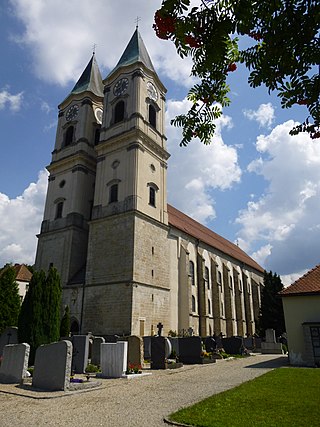
Niederaltaich Abbey is a house of the Benedictine Order founded in 741, situated in the village of Niederalteich on the Danube in Bavaria.

Vornbach Abbey was a Benedictine monastery in Neuhaus am Inn in Bavaria, Germany.

St. Peter's Abbey on the Madron was a Benedictine monastery in Flintsbach am Inn in Bavaria, Germany. The church, now a pilgrimage church known as the Peterskirchlein, still stands on the site.

Theres Abbey was a Benedictine monastery in the village of Theres in the district of Hassberge, in Franconia in the north of Bavaria, Germany.

Schäftlarn Abbey is a Benedictine monastery on the Isar in Schäftlarn, south of Munich in Bavaria, Germany.
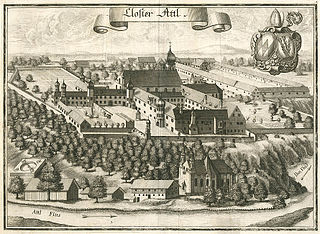
Attel Abbey, also Attl Abbey, was a Benedictine monastery, later a home for the disabled run by the Brothers Hospitallers, in the village of Attel near Wasserburg am Inn in Bavaria, Germany.

Braunau in Rohr Abbey is a Benedictine monastery, formerly Rohr Abbey, a monastery of the Augustinian Canons, in Rohr in Niederbayern in the district of Kelheim in Bavaria, Germany.

Mondsee Abbey was a Benedictine monastery in Mondsee in Upper Austria.
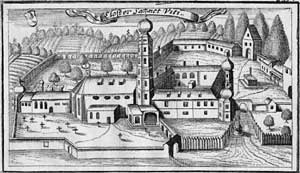
St. Vitus' Abbey, occasionally also St. Vitus' Abbey on the Rott, was a Benedictine monastery in the municipality of Neumarkt-Sankt Veit in the district of Mühldorf in Bavaria, Germany.

Banz Abbey, now known as Banz Castle, is a former Benedictine monastery, since 1978 a part of the town of Bad Staffelstein north of Bamberg, Bavaria, southern Germany.

Fürstenfeld Abbey is a former Cistercian monastery in Fürstenfeldbruck, Bavaria, Germany.
Ursberg Abbey is a former Premonstratensian monastery, now a convent of the Franciscan St. Joseph's Congregation, situated in the small village of Ursberg in the district of Günzburg, Bavaria.
Roggenburg Abbey is a Premonstratensian canonry in Roggenburg near Neu-Ulm, Bavaria, in operation between 1126 and 1802, and again from its re-foundation in 1986. Since 1992 it has been a dependent priory of Windberg Abbey in Lower Bavaria. The monastery manages a training centre and a museum, and is widely known for its almost unchanged Baroque building and the organ concerts that are held in the church.
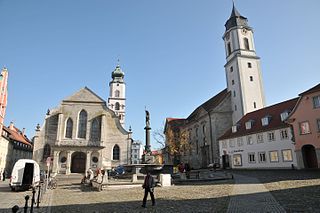
Lindau Abbey was a house of secular canonesses in Lindau on the Bodensee in Bavaria, Germany, which stands on an island in the lake.

Erlach Abbey or St. Johannsen Abbey was a Benedictine monastery in Gals, Canton of Bern, Switzerland.
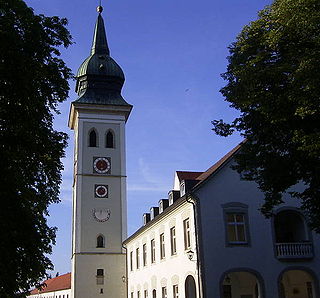
Rottenbuch Abbey in Rottenbuch was founded as an Augustinian monastery in 1073 on land granted by Duke Welf I of Bavaria and his wife Judith of Flanders. The Abbey church was constructed between 1085 and 1125 in the Romanesque style. The design of a crossing transept and free-standing tower is unusual for a Bavarian church. Rottenbuch was a center of papal loyalty during the Investiture Controversy. Under the patronage of Emperor Louis the Bavarian in the 14th century, together with its location on the pilgrimage route to Italy, Rottenbuch became the most influential house of Canons Regular in Germany.
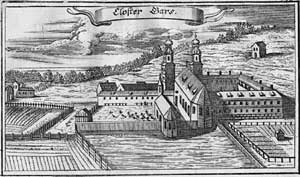
Gars Abbey is a monastery on the Inn River in Bavaria, Germany, in the town of Gars am Inn. It was founded in 768 and has been occupied by Benedictine monks, Augustinian Canons Regular, and most recently Redemptorists.
























